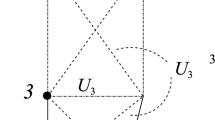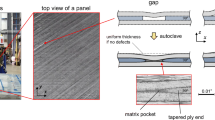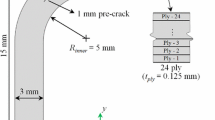A modern aeronautical structure is made of a laminated composite in which plies are terminated at discrete position to provide taperness. Ply termination is called ply-drop. Thickness variation in laminated composite is achieved by changing the number of plies in proportion to the thickness change. It requires the termination of plies within the laminate. In the present study, two different ply-drop configurations are taken for the analysis under tensile loading: overlapped-grouped and overlapped-dispersed. Commercial finite-element software ANSYS 14.0 is used for the analysis. To construct the model geometry, layered 3-D finite element (SOLID 20 node 186) is considered which have six degrees of freedom at each node. The Tsai–Wu criterion is implemented to obtain the value of the failure factor for separate plies. Interlaminar stress variations along the interface of plies are determined to initialize possible delamination sites. For both configurations the value of the failure factor is found to be maximum at the position of the first resin pocket tip. In case of overlapped-grouped, delamination growth occurs at a position near the thin section but in case of overlapped-dispersed it is spread over discrete positions over the laminate.
Similar content being viewed by others
References
J. C. Fish and A. J. Vizzini, “Delamination of ply-drop configurations,” Compos. Mater. Test. Design, No. 11, 323–332 (1993).
W. Woigk, S. R. Hallett, M. I. Jones, M. Kuhtz, A. Hornig, and M. Gude, “Experimental investigation of the effect of defects in automated fibre placement produced composite laminates,” Compos. Struct., 201, 1004–1017 (2018).
D. S. Cairns, J. F. Mandell, and M. E. Scott, “Design and manufacturing consideration for ply drops in composite structures,” Composites, Part B, 30, 523–534 (1999).
B. Varughese and A. Mukherjee, “A ply drop-off element for analysis of tapered laminated composites,” Compos. Struct., 39, No. 1–2, 123–144 (1997).
C. A. Steeves and N. A. Fleck, “Compressive strength of composite laminates with terminated internal plies,” Composites, Part A, 36, 798–805 (2005).
S. Long, X. Yao, and X. Zhang, “Delamination prediction in composite laminates under low-velocity impact,” Compos. Struct., 132, No. 15, 290–298 (2015).
B. R. Vidyashankar and A. V. Krishna Murty, “Analysis of laminate with ply drops,” Compos. Sci. Technol., 61, 749–758 (2001).
B. Zhang, L. F. Kawashita, M. I. Jones, J. K. Lander, and S. R. Hallett, “An experimental and numerical investigation into damage mechanisms in tapered laminates under tensile loading,” Composites, Part A: Appl. Sci. Manufact., 133, 105862 (2020).
J. M. Curry, E. R. Johnson, and J. H. Starnes, Jr., “Effect of dropped plies on the strength of graphite-epoxy laminates,” in: Proc. AIAA/ ASME/ASCE/AHS/ASC 29th Structures, Structural Dynamics, Materials Conf. Part I, Monterey, CA, AIAA paper No. 87-084 (1987), pp. 737–747.
N. V. De Carvalho, B. Y. Chen, S. T. Pinho, J. G. Ratcliffe, P. M. Baiz, and T. E. Tay, “Modeling delamination migration in cross-ply tape laminates,” Composites, Part A: Appl. Sci. Manufact., 71, 192–203 (2015).
J. Wang, K. D. Potter, and J. Etches, “Experimental investigation and characterisation techniques of compressive fatigue failure of composites with fibre waviness at ply drops,” Compos. Struct., 100, 398–403 (2013).
J. S. Kim, C. G. Kim, and C. S. Hong, “Optimum design of composite structures with ply drop using genetic algorithm and expert system shell,” Compos. Struct., 46, 171–187 (1999).
F. Mortensen and O. T. Thomsen, “Simple and efficient interlaminar stressanalysis of composite laminates with internal ply-drop,” Compos. Struct., 84, No. 1, 73–86 (2008).
P. D. Mangalgiri and K. Vijayaraju, “An analytical study on 0/90 ply-drops in composite laminate,” Compos. Struct., 28, 181–185 (1994).
S. C. Her, “Stress analysis of ply drop-off in composite structure,” Compos. Struct., 57, 235–244 (2002).
M. F. Pernice, N. V. De Carvalho, J. G. Ratcliffe, and S. R. Hallett, “Experimental study on delamination migration in composite laminates,” Composites, Part A: Appl. Sci. Manufact., 73, 20–34 (2015).
M. K. Budzik, S. H. Jorgensen, and R. Aghababaei, “Fracture mechanics analysis of delamination along width-varying interfaces,” Composites, Part B: Engineering, 215, 108793 (2021).
M. Hussain, Y. Abdel-Nasser, A. Banawan, and Y. M. Ahmed, “Failure analysis of tapered composite propeller blade,” Ocean Eng., 236, 109506 (2021).
S. K. Morton, J. P. H. Webber, and D. M. Thomas, “Design and assessment of composite tapered laminated plates,” Department of Aerospace Engineering, Department of Eng. Math., 2763–2773 (1994).
W. Cui, M. R. Wisnom, and M. I. Jones, “Effect of step spacing on delamination of taper laminates,” Compos. Sci. Technol., 52, 39–46 (1994).
P. Dhurvey and N. D. Mittal, “Study the effect of externally and internally ply drop-off in composite laminate analysis,” ARPN J. Eng. Appl. Sci., 8, No. 4 (2013).
J. Yang, B. Song, X. Zhong, and P. **, “Optimal design of blended composite laminate structuresusing ply drop sequence,” Compos. Struct., 135, 30–37 (2016).
F. X. Irisarri, A. Lasseigne, F. H. Leroy, and R. Le. Riche, “Optimal design of laminated composite structures with ply drops using stacking sequence tables,” Compos. Struct., 107, 559–569 (2014).
P. F. Liu, S. J. Hou, J. K. Chu, X. Y. Hu, C. L. Zhou, Y. L. Liu, J. Y. Zheng, A. Zhao, and L. Yan, “Finite element analysis of postbuckling and delamination of composite laminates using virtual crack closure technique,” Compos. Struct., 93, No. 6, 1549–1560 (2011).
W. Woigk, B. Zhang, M. I. Jones, M. Kuhtz, A. Hornig, M. Gude, and S. R. Hallett, “Effect of saw-tooth ply drops on the mechanical performance of tapered composite laminates,” Compos. Struct., 272, 114197 (2021).
T. Gordon, X. Xu, L. Kawashita, M. R. Wisnom, S. R. Hallett, and B. C. Kim, “Delamination suppression in tapered unidirectional laminates with multiple ply drops using a tape scarfing technique,” Composites, Part A: Appl. Sci. Manufact., 150, 106627 (2021).
S. Obata, K. Takahashi, and K. Inaba, “Laminate design for a tapered FRP structure with ply drop-off based on yielding of resin pockets,” Compos. Struct., 253, 112787 (2020).
T. Gordon, X. Xu, M. R. Wisnom, and B. C. Kim, “Novel tape termination method for automated fibre placement: Cutting characteristics and delamination suppression,” Composites, Part A: Appl. Sci. Manufact., 137, 106023 (2020).
Author information
Authors and Affiliations
Corresponding author
Additional information
Published in Prykladna Mekhanika, Vol. 58, No. 5, pp. 133–144, September–October 2022.
Rights and permissions
Springer Nature or its licensor (e.g. a society or other partner) holds exclusive rights to this article under a publishing agreement with the author(s) or other rightsholder(s); author self-archiving of the accepted manuscript version of this article is solely governed by the terms of such publishing agreement and applicable law.
About this article
Cite this article
Chaudhary, G., Dey, A. & Dey, A.K. Stress and Delamination Analysis on Overlapped-Grouped and Overlapped-Dispersed Tapered Composite Laminate. Int Appl Mech 58, 613–622 (2022). https://doi.org/10.1007/s10778-023-01185-2
Received:
Published:
Issue Date:
DOI: https://doi.org/10.1007/s10778-023-01185-2




